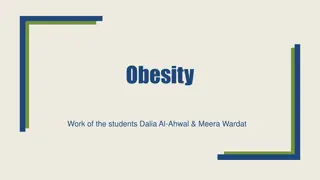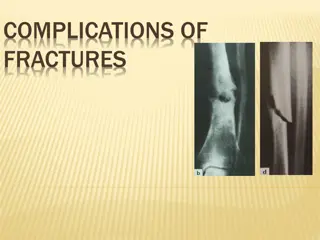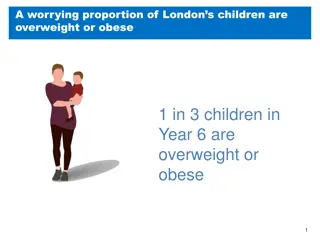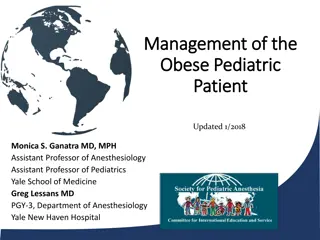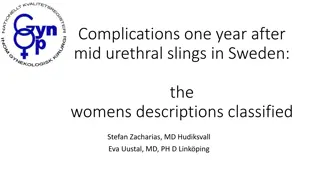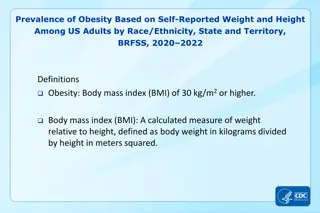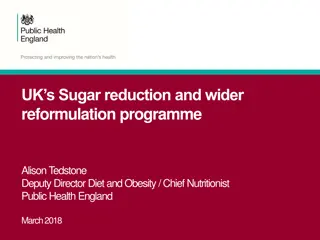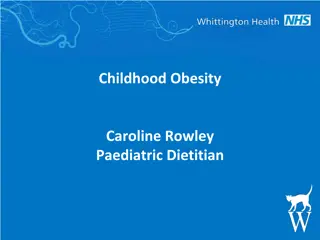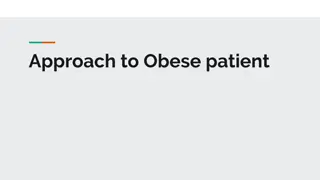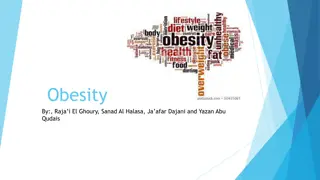Distribution of Direct Healthcare Costs and Obesity-Related Complications Among High-Cost Individuals Living with Obesity
This UK retrospective cohort study examines the demographic and clinical characteristics of individuals living with obesity who contribute most to direct healthcare costs. The study uses data from the UK Discover database to stratify individuals with obesity into quintiles and assess their contribution to total healthcare costs in 2019. By identifying high-cost individuals with obesity, the study aims to shed light on the economic impact of obesity-related complications. The research emphasizes the importance of managing obesity to reduce healthcare costs and improve resource utilization.
Download Presentation

Please find below an Image/Link to download the presentation.
The content on the website is provided AS IS for your information and personal use only. It may not be sold, licensed, or shared on other websites without obtaining consent from the author.If you encounter any issues during the download, it is possible that the publisher has removed the file from their server.
You are allowed to download the files provided on this website for personal or commercial use, subject to the condition that they are used lawfully. All files are the property of their respective owners.
The content on the website is provided AS IS for your information and personal use only. It may not be sold, licensed, or shared on other websites without obtaining consent from the author.
E N D
Presentation Transcript
Distribution of direct healthcare costs and obesity-related complications among high-cost individuals living with obesity: a UK retrospective open cohort study Jonathan Pearson-Stuttard,1,2Sara Holloway,1 Kasper Sommer Matthiessen,3Andrew Thompson,1,4 Silvia Capucci3 1Lane Clark & Peacock LLP, London, UK 2Department of Epidemiology and Biostatistics, School of Public Health, Imperial College London, London, UK 3Novo Nordisk A/S, S borg, Denmark 4Wolfson Centre for Personalised Medicine, Institute of Systems, Molecular and Integrative Biology, University of Liverpool, Liverpool, UK Pearson-Stuttard J et al. presented at the 30th European Congress on Obesity, 17 20 May 2023, Dublin, Ireland. Presentation number: AD02.05
Introduction Depression Increasing BMI is associated with the development of ORCs, which contribute to healthcare costs and resource utilization for people with obesity.1 Respiratory conditions CVD An analysis using US data has suggested that the majority of direct healthcare costs in groups with obesity are contributed by a minority of individuals, who frequently have ORCs.2 Gastrointestinal conditions CKD Musculoskeletal conditions T2D 1. Divino V et al. J Manag Care Spec Pharm 2021;27(2):210 22. 2. Pearson-Stuttard J et al. Poster presentation at the Zoom Forward 22 ECO/IFSO-EC Congress on Obesity, 4 7 May 2022, Maastricht, Netherlands. Presentation number 177. BMI, body mass index; CKD, chronic kidney disease; CVD, cardiovascular disease; ORC, obesity-related complication; T2D, type 2 diabetes. Pearson-Stuttard J et al. presented at the 30th European Congress on Obesity, 17 20 May 2023, Dublin, Ireland. Presentation number: AD02.05
Aims In this real-world, retrospective open cohort study, we used data from the UK Discover database to examine the demographic and clinical characteristics of people living with obesity who contributed the most to direct healthcare costs. Individuals with obesity were stratified into quintiles to assess the contribution of each quintile to the total direct healthcare costs in 2019. Pearson-Stuttard J et al. presented at the 30th European Congress on Obesity, 17 20 May 2023, Dublin, Ireland. Presentation number: AD02.05
Discover Accounting for >95% of the population of North West London Linked electronic health records research dataset covering 2.8 million individuals across 365 primary care practices in North West London, UK.1 Representative of the UK population with regard to age and sex, but more diverse in terms of ethnicity1 and deprivation. Sources of linked data Primary care:a EMRs, prescriptions. Secondary care:a demographics, dates of activity, diagnoses and procedures. aPrimary care data are available from 2004, with linkage to secondary care data from 2015. 1. Bottle A et al. BMC Med Inform Decis Mak 2020;20(1):71. EMR, electronic medical record. Pearson-Stuttard J et al. presented at the 30th European Congress on Obesity, 17 20 May 2023, Dublin, Ireland. Presentation number: AD02.05
Outcomes Healthcare costs PPPY for 2019 were calculated using the following data Primary care costs, derived from the Personal Social Services Research Unit (2020). Secondary care costs (inpatient and outpatient care and emergency department visits), derived from the Secondary Uses Service. Prescription costs, calculated using UK net ingredient costs. All outcomes were age-standardized to the European Standard Population 2013,1 and costs were adjusted to 2019 costs using UK Consumer Price Index inflation data from the ONS. 1. Eurostat 2013. Available from: https://ec.europa.eu/eurostat/web/products-manuals-and-guidelines/-/KS-RA-13-028 (Accessed 14 February 2023). ONS, Office for National Statistics; PPPY, per person per year. Pearson-Stuttard J et al. presented at the 30th European Congress on Obesity, 17 20 May 2023, Dublin, Ireland. Presentation number: AD02.05
Study design and population Real-world, retrospective open cohort study At index Inclusion criteria Baseline characteristics defined Comorbidities Age 18 years Demographics BMI 30 kg/m2 Risk factors Over follow-up: serial cross-sections assembled to assess outcomes per year Comorbidity prevalence and risk factors reassessed to reflect current health status Healthcare utilization and costs (primary care, hospital care and prescriptions) 2019b Patients followed for up to 5 years, until month of death, transfer out date or end of study period, whichever was earliest. Index datea aDate of first eligible BMI measurement during the study period (1 January 2015 31 December 2019). bAlthough data are available in Discover up to 2022, the study followed up patients until 2019 to avoid the potential effect of the COVID-19 pandemic on healthcare utilization and outcomes. BMI, body mass index. Pearson-Stuttard J et al. presented at the 30th European Congress on Obesity, 17 20 May 2023, Dublin, Ireland. Presentation number: AD02.05
Results Baseline characteristics of people living with obesity in the Discover database In total, there were 590,291 individuals witha BMI measurement of 30 kg/m2 at any time during 2004 2019. Hypertension 27.8% Mean (SD) age: 44.0 (15.9) years. Back pain 22.4% Osteoarthriti s 12.4% Sex: 54.6% women. More than 40% had 2 ORCs.a ASCVD 8.6% Depression 3.8% aORCs included in the total were ASCVD, asthma, back pain, CKD stage 3 5, dyslipidaemia, gastro-oesophageal reflux disease, HF, hypertension, obstructive sleep apnoea, osteoarthritis of the knee, polycystic ovary syndrome, prediabetes, psoriasis, T2D and urinary incontinence. ASCVD, atherosclerotic cardiovascular disease; BMI, body mass index; CKD, chronic kidney disease; HF, heart failure; ORC, obesity-related complication; SD, standard deviation, T2D, type 2 diabetes. Pearson-Stuttard J et al. presented at the 30th European Congress on Obesity, 17 20 May 2023, Dublin, Ireland. Presentation number: AD02.05
Baseline demographics for the 2019 cross-section A total of 270,493 individuals were included in the 2019 cross-section. Mean age was approximately 13 years higher in the highest-cost quintile (Q5) than in the lowest-cost quintile (Q1) and a greater proportion were women. Mean BMI in 2019 was highest in the quintiles with the highest costs. Baseline characteristic Obesity (N=270,493) Q1 Q2 Q3 Q4 Q5 Age in 2019, years, mean (SD) 49.9 (16.3) 41.3 (13.3) 44.7 (14.3) 50.2 (15.2) 54.5 (15.4) 58.9 (16.5) Women, n (%) 153,751 (56.8) 24,618 (45.5) 30,388 (56.2) 32,079 (59.3) 32,955 (60.9) 33,711 (62.3) BMI in 2019, kg/m2, mean (SD) 34.6 (4.9) 34.2 (4.9) 34.2 (4.7) 34.5 (4.8) 34.8 (5.0) 35.1 (5.3) Q, quintile; SD, standard deviation. Pearson-Stuttard J et al. presented at the 30th European Congress on Obesity, 17 20 May 2023, Dublin, Ireland. Presentation number: AD02.05
The highest-cost quintile (Q5) accounted for over 70% of the direct healthcare costsa in 2019 Total direct costs PPPY were 1445 in the overall cohort with obesity. Q5 accounted for more than 72% of the total direct healthcare costs in 2019. There was an almost five-fold increase in costs from Q4 to Q5. aAll costs are age-standardized to the European Standard Population1 and adjusted to 2019 prices. 1. Eurostat 2013. Available from: https://ec.europa.eu/eurostat/web/products-manuals-and-guidelines/-/KS-RA-13-028 (Accessed 14 February 2023). GBP, pound sterling; PPPY, per person per year; Q, quintile. Pearson-Stuttard J et al. presented at the 30th European Congress on Obesity, 17 20 May 2023, Dublin, Ireland. Presentation number: AD02.05
Individuals in the highest-cost quintile were considerably more likely to have 3 ORCsa or 2 ORCsa aORCs were ASCVD, asthma, back pain, CKD stage 3 5, dyslipidaemia, gastro-oesophageal reflux disease, HF, hypertension, obstructive sleep apnoea, osteoarthritis of the knee, polycystic ovary syndrome, prediabetes, psoriasis, T2D and urinary incontinence. Prevalence was age-standardized to the European Standard Population in 2013. bPrevalence for each comorbidity was calculated at mid-year (1 July) in the calendar year analysis. ASCVD, atherosclerotic cardiovascular disease; CKD, chronic kidney disease; HF, heart failure; ORC, obesity-related complication; Q, quintile; T2D, type 2 diabetes. Pearson-Stuttard J et al. presented at the 30th European Congress on Obesity, 17 20 May 2023, Dublin, Ireland. Presentation number: AD02.05
Individuals in the highest-cost quintile were more likely to have ASCVD, T2D or depression aPrevalence for each comorbidity was calculated at mid-year (1 July) in the calendar year analysis. ASCVD, atherosclerotic cardiovascular disease; ORC, obesity-related complication; Q, quintile; T2D, type 2 diabetes. Pearson-Stuttard J et al. presented at the 30th European Congress on Obesity, 17 20 May 2023, Dublin, Ireland. Presentation number: AD02.05
Conclusions In a UK real-world population with obesity, 20% of individuals accounted for over 70% of the direct healthcare costs in 2019. Older age, female sex and a higher likelihood of multiple ORCs (especially ASCVD, T2D and depression) were characteristic of the highest-cost quintile in our analyses. These findings are important to guide the allocation of limited healthcare resources towards people living with obesity who have the greatest unmet need. ASCVD, atherosclerotic cardiovascular disease; ORC, obesity-related complication; T2D, type 2 diabetes. Pearson-Stuttard J et al. presented at the 30th European Congress on Obesity, 17 20 May 2023, Dublin, Ireland. Presentation number: AD02.05






